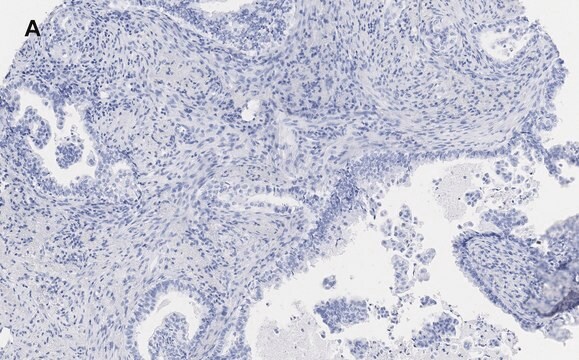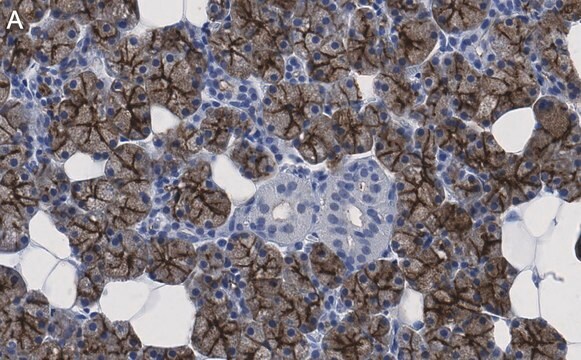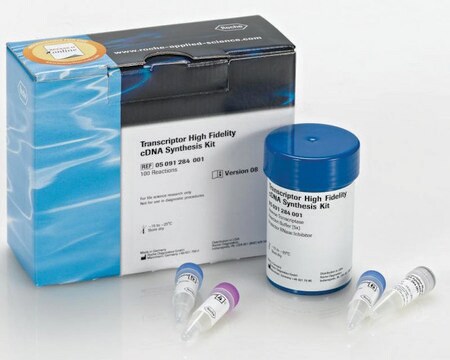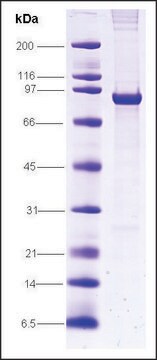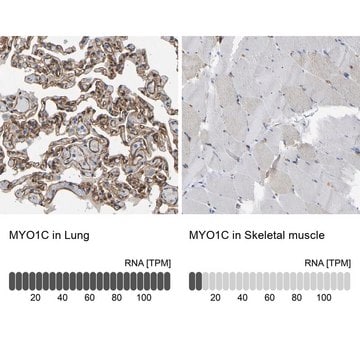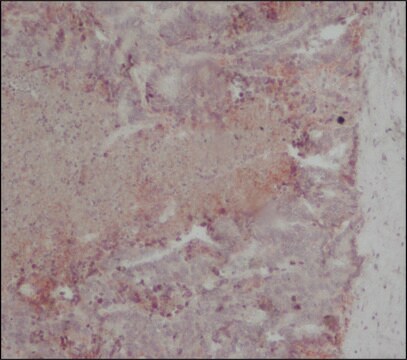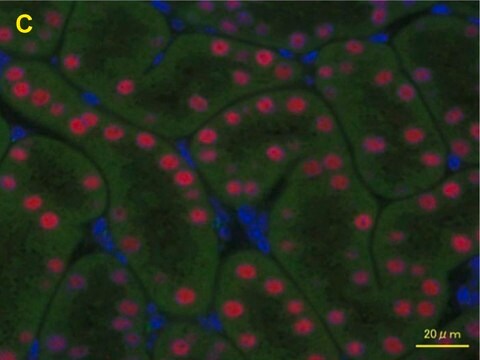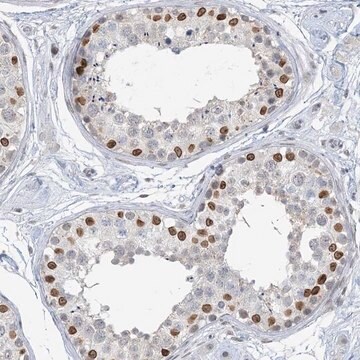MABS1221
Anti-GLEPP1/PTPRO Antibody, clone 5C11
clone 5C11, from mouse
别名:
Receptor-type tyrosine-protein phosphatase O, Glomerular epithelial protein 1, Osteoclastic transmembrane protein-tyrosine phosphatase, Protein tyrosine phosphatase U2, PTP-OC, PTP phi, PTP-U2, PTPase U2, R-PTP-O
登录查看公司和协议定价
所有图片(1)
About This Item
分類程式碼代碼:
12352203
eCl@ss:
32160702
NACRES:
NA.41
推荐产品
生物源
mouse
品質等級
抗體表格
purified antibody
抗體產品種類
primary antibodies
無性繁殖
5C11, monoclonal
物種活性
human
應無反應活性
mouse, rat, rabbit
技術
electron microscopy: suitable
immunofluorescence: suitable
immunohistochemistry: suitable
同型
IgG2bκ
NCBI登錄號
UniProt登錄號
運輸包裝
wet ice
目標翻譯後修改
unmodified
基因資訊
human ... PTPRO(5800)
一般說明
Receptor-type tyrosine-protein phosphatase O (EC 3.1.3.48; UniProt Q16827; also known as Glomerular epithelial protein 1, Osteoclastic transmembrane protein-tyrosine phosphatase, Protein tyrosine phosphatase U2, PTP-OC, PTP phi, PTP-U2, PTPase U2, R-PTP-O) is encoded by the PTPRO (also known as GLEPP1, NPHS6, PTPROT, PTPU2) gene (Gene ID 5800) in human. Podocytes are complex neuron-like post-mitotic cells adherent to the underlying glomerular basement membrane via foot processes that must contiguously cover the filtration surface area to maintain the normal filtration barrier. Glomerular epithelial protein 1 (GLEPP1) is a podocyte receptor membrane protein tyrosine phosphatase located on the apical cell membrane of visceral glomerular epithelial cell (VGEC) foot processes and is commonly used as a podocyte marker for assessing podocyte density. Altered GLEPP1 staining patterns are reported in kidney sections from individuals with congenital nephrotic syndrome of the Finnish type (CNF), minimal-change nephropathy (MCN), and Hodgkin’s disease. GLEPP1 is initially produced with a signal peptide sequence (a.a. 1-29), the removal of which yields the mature protein with a large extracellular region (a.a. 30-822), followed by a transmembrane segment (a.a. 823-843) and a cytoplasmic domain (a.a. 844-1216).
特異性
Clone 5C11 recognizes GLEPP1 (PTPRO) in human podocytes and neurons, but not GLEPP1 spliced isoforms lacking Fibronectin type-III domains 1-5 in their extracellular region in many other cells. Clone 5C11 detected a 200 kD protein band in glomerular extracts by Western blotting under both reducing and nonreducing conditions and immunostained only visceral glomerular epithelial cell (VGEC) in human renal cortex tissues by both fluorescent and non-fluorescent immunohistochemistry (Sharif, K., et al. (1998). Exp. Nephrol. 6(3):234-244).
免疫原
Epitope: Fibronectin type-III domains 1-5.
GST-tagged recombinant fragment corresponding to the Fibronectin type-III domains 1-5 of human GLEPP1/PTPRO.
應用
Detect GLEPP1/PTPRO using this Anti-GLEPP1/PTPRO Antibody, clone 5C11 validated for use in Immunohistochemistry, Immunofluorescence, Electron Microscopy.
Immunohistochemistry Analysis: A representative lot detected a loss of GLEPP1 immunoreactivity as a measure of podocyte density reduction (podocyte depletion) in kidney tissues with transplant glomerulopathy using formalin-fixed, paraffin-embedded kidney sections (Yang, Y., et al. (2015). J. Am. Soc. Nephrol. 26(6):1450-1465).
Immunofluorescence Analysis: Prior to purification, clone 5C11 hybridoma culture supernatant detected GLEPP1 (PTPRO) immunoreactivity predominantly on visceral glomerular epithelial cell (VGEC) foot processes along the glomerulus (GBM) in manthanol-fixed, adult human kidney cryosections, while altered GLEPP1 staining patterns were seen in kidney sections from individuals with congenital nephrotic syndrome of the Finnish type (CNF), minimal-change nephropathy (MCN), or Hodgkin’s disease (Sharif, K., et al. (1998). Exp. Nephrol. 6(3):234-244).
Electron Microscopy Analysis: Prior to purification, clone 5C11 hybridoma culture supernatant detected GLEPP1 (PTPRO) immunoreactivity at the apical aspect of the foot processes and the cell membrane of larger processes in paraformaldehyde-fixed, paraffin-embedded normal human adult kidney sections, while GLEPP1 immunoreactivity was seen redistributed from glomerulus (GBM) on the apical cell membrane of VGECs to microvilli on kidney sections from individuals with congenital nephrotic syndrome of the Finnish type (CNF) or minimal-change nephropathy (MCN) (Sharif, K., et al. (1998). Exp. Nephrol. 6(3):234-244).
Immunofluorescence Analysis: Prior to purification, clone 5C11 hybridoma culture supernatant detected GLEPP1 (PTPRO) immunoreactivity predominantly on visceral glomerular epithelial cell (VGEC) foot processes along the glomerulus (GBM) in manthanol-fixed, adult human kidney cryosections, while altered GLEPP1 staining patterns were seen in kidney sections from individuals with congenital nephrotic syndrome of the Finnish type (CNF), minimal-change nephropathy (MCN), or Hodgkin’s disease (Sharif, K., et al. (1998). Exp. Nephrol. 6(3):234-244).
Electron Microscopy Analysis: Prior to purification, clone 5C11 hybridoma culture supernatant detected GLEPP1 (PTPRO) immunoreactivity at the apical aspect of the foot processes and the cell membrane of larger processes in paraformaldehyde-fixed, paraffin-embedded normal human adult kidney sections, while GLEPP1 immunoreactivity was seen redistributed from glomerulus (GBM) on the apical cell membrane of VGECs to microvilli on kidney sections from individuals with congenital nephrotic syndrome of the Finnish type (CNF) or minimal-change nephropathy (MCN) (Sharif, K., et al. (1998). Exp. Nephrol. 6(3):234-244).
品質
Evaluated by Immunohistochemistry in human kidney tissue.
Immunohistochemistry Analysis: A 1:50 dilution of this antibody detected GLEPP1/PTPRO in human kidney tissue.
Immunohistochemistry Analysis: A 1:50 dilution of this antibody detected GLEPP1/PTPRO in human kidney tissue.
標靶描述
200 kDa calculated.
外觀
Format: Purified
其他說明
Concentration: Please refer to lot specific datasheet.
未找到合适的产品?
试试我们的产品选型工具.
儲存類別代碼
12 - Non Combustible Liquids
水污染物質分類(WGK)
WGK 1
閃點(°F)
Not applicable
閃點(°C)
Not applicable
Kathryn E Haley et al.
Frontiers in physiology, 12, 625762-625762 (2021-08-03)
Podocyte loss plays a pivotal role in the pathogenesis of glomerular disease. However, the mechanisms underlying podocyte damage and loss remain poorly understood. Although detachment of viable cells has been documented in experimental Diabetic Nephropathy, correlations between reduced podocyte density
Extracellular Matrix Injury of Kidney Allografts in Antibody-Mediated Rejection: A Proteomics Study.
Sergi Clotet-Freixas et al.
Journal of the American Society of Nephrology : JASN, 31(11), 2705-2724 (2020-09-10)
Antibody-mediated rejection (AMR) accounts for >50% of kidney allograft loss. Donor-specific antibodies (DSA) against HLA and non-HLA antigens in the glomeruli and the tubulointerstitium cause AMR while inflammatory cytokines such as TNFα trigger graft injury. The mechanisms governing cell-specific injury
我们的科学家团队拥有各种研究领域经验,包括生命科学、材料科学、化学合成、色谱、分析及许多其他领域.
联系技术服务部门